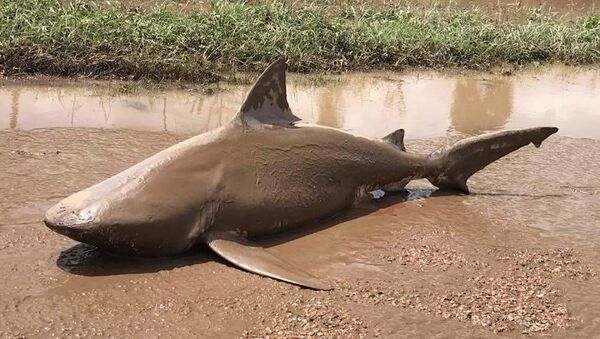Cyclone Debbie caused havoc making its way through New South Wales (NSW) and southern Queensland, Australia on March 28. Thousands of people had to be evacuated from their homes as floodwaters continued to rise. Some areas had about three times their monthly rainfall on March 30.
As a result of the floods, the waters in the area may now contain snakes, crocodiles and sharks.
An image appeared on social media showing the impact of Cyclone Debbie — a large bull shark washed up on a road near the town of Ayr in NSW.
#Sharknado. Locals at #Ayr sadly discover another of the untold thousands of marine and land animals that were victims of #CycloneDebbie pic.twitter.com/tMf2WBomQH
— Marcus Middleton (@MMiddleton_10) March 30, 2017
However it's not just sharks that have been spotted in the Australian floodwaters, snakes and crocodiles are also lurking in the aftermath of the ex-cyclone.
"Flooded waterways increase the possibilities of crocodiles and other animals, such as snakes turning up in unexpected places," a spokesperson for the state's Department of Environment and Heritage Protection said.
"In most circumstances, crocodiles will be moving through, trying to get out of fast-flowing creeks and waterways to the quieter areas they prefer. Snakes are good swimmers and they too may turn up in unexpected places and may even find their way into people's properties," they added.
The only victim of Burdekin flooding…a bull shark. #CycloneDebbie @WINNews_TVL pic.twitter.com/ZXZGlAVV16
— Philip Calder (@philipjcalder) March 30, 2017
The picture of the bull shark was taken by paramedic Lisa Smith who at first mistook it for a dolphin.
"At first I thought it was a dolphin, but then I thought 'nah, there wouldn't be any dolphins around here. I thought there were just crocs in that river. This should definitely teach people to never walk in floodwaters as you never know what's in them," Ms. Smith said in a recent interview.
Some people even offered to remove the reptiles for free after the cyclone hit. Anthony Bailey, a snake catcher from Queensland was inundated with requests to remove the sharks and snakes. Bailey said snakes were fond of slithering indoors in wet conditions.
"They don't like sitting out in the rain, they come into houses or trees to escape the water and possibly looking for some warmth," he said.
Out of 25 of the world's most venomous snakes, Australia is home to 20 species, including the top ten.
Brown snakes, among the most venomous, are common in eastern Australia and can be as much as two metres (six feet) long when fully grown. Their bite can be fatal to humans.


